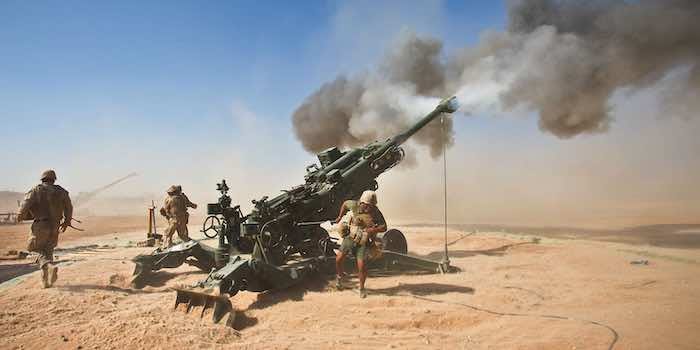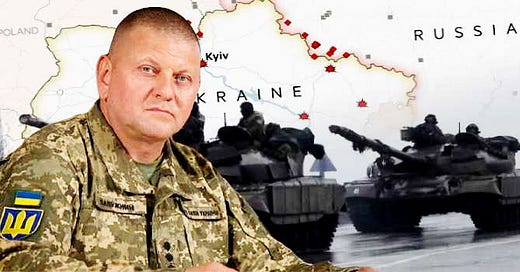Russo-Ukrainian War: What Zaluzhnyi Actually Wrote
Positional forms favor Russia. Ukraine must implement FIVE non-trivial transformations to overcome the positional crisis
William Walter Kay BA JD - NOV 15, 2023
The clearest, most authoritative, and comprehensive depiction of the current state of the Russo-Ukrainian War is Ukrainian Commander-in-Chief Valerii Zaluzhnyi’s recent 4,500-word treatise: Modern Positional Warfare and How to Win in It. Here’s a high-fidelity abridgement of that document. (Western military equipment, endorsed by Zaluzhnyi, are hyperlinked to their corporate brochures.)
Mid-2023 the Russo-Ukrainian War assumed positional (non-maneuverable) forms reminiscent of 1914-18 trench warfare. Positional forms favor Russia. Ukraine must implement FIVE non-trivial transformations to overcome the positional crisis.
I. Gain Air Superiority
Ukraine began the war with 120 combat aircraft (40 utilizable) and 33 anti-aircraft missile batteries. Partners supplied combat aircraft and Soviet helicopters. Ukraine’s Western anti-aircraft arsenal now includes:
Man-portable anti-aircraft missiles: Starstreak, Javelin, Mistral, Stinger, Grom, Martlet;
Gepard self-propelled anti-aircraft guns;
Integrated air-defence systems: Skynex, Avenger, Stormer, Patriot, Hawk, IRIS-T-SL, NASAMS, SAMP-T, Crotale-NG.
With partner-supplied weapons Ukraine destroyed “13 regiments (brigades) of army aviation” and 550 pieces of air-defence equipment. Regardless, Russia retains air superiority.
Russia cannot translate air superiority into air domination. Russian pilots don’t enter Ukrainian anti-aircraft kill-zones; rather, they shoot missiles from long ranges--with reduced effectiveness. Drones perform much of Russia’s aviation task-load.
Recommendations:
Overload Russian air-defences with swarms of cheap drones;
Baffle Russia’s frontline “illumination” (targeting) stations with simulators;
Blind Russia’s thermal imaging reconnaissance with strobe-lights;
Counter Russian drones with local jammers, anti-drone guns and hunter-drones with nets.
II. Breaching Mine Barriers
Mine barriers form the backbone of positional warfare.
Ukrainian engineering units breech mine barriers with M58MICLICs, Wisents, and Ingeniorpanservogns, however, unprecedented minefield sizes belittle Ukrainian accomplishments.
Along critical axes high-density Russian minefields reach depths of 20 kilometres. Russian reconnaissance drones easily detect Ukrainian mine-clearing teams and guide fire upon them. Russia replenishes cleared fields quickly, often with remote mine-laying munitions.
Ukraine is equally adept at maintaining minefields.
Recommendations:
LiDAR laser-scanners to improve situational awareness;
Rosy smoke screens, and anti-drone guns, to counter reconnaissance of mine-clearing teams;
For non-dug-in mines: jet engines from retired aircraft, water cannons, and cluster bombs;
For dug-in mines: mini-tunnel excavating drills, Rapid Burrowing Robots, liquid explosive injection hoses and thermobaric bombardment.
III. Build-up Electronic Warfare (EW) Capabilities
Russia’s EW Force (est. 2009) deploys 60 types of EW equipment. Russia enjoys EW superiority through mass production, and saturation positioning, of tactical “trench-EW” systems. Along the Kupyansk and Bakhmut axes, Russia deploys layered EW systems with constantly moving components.
At war’s commencement 65% of Ukraine’s jammers were Soviet-made. Ukraine possessed only 25 pieces of modern EW equipment. AFU achieved EW performance parity using Western-made: drones, anti-drone guns, tactical mobile direction-finding systems, and EW systems with on-board radar.
Surmounting the positional crisis requires EW superiority.
Countering Russian guided missiles requires blanket satellite reception suppression.
Recommendations:
Replace satellite navigation;
Enhance drone-borne EW capability;
Increase Bukovel-Ads production;
Weaponize the full electromagnetic spectrum.
IV. Improve Counter-Artillery Effectiveness
Missile and artillery activity constitute 70% of Ukrainian combat tasks.
Western missiles and artillery give Ukraine counter-artillery superiority.
Hunting Russian artillery is hampered by Russia’s deployment of volumes of Soviet-made guns. Russia combines large numbers with wide dispersal and maximum range use.
Precision munitions (HIMARS and Excalibur 155mm shells) work well, however, all GPS-guided weapons suffer diminishing effectiveness due to Russian EW advances.
In addition to reconnaissance drones and powerful mobile jammers, modern Russian counter-artillery assets include kamikaze drones, and precision artillery, guided by ground or drone target illumination.
Recommendations:
Local positioning systems to guide munitions;
Kamikaze drones.

V. Create and Train Necessary Reserves
Russia commands three times more mobilizable human resources than Ukraine, but doesn’t capitalize on this advantage because Putin fears mass mobilization will inflame social tensions into political crises.
Gaps in legislation allow many Ukrainians to legally evade mobilization. Training on Ukrainian territory is challenging due to Russian strikes on training centres. Said problems preclude numerical superiority and limit troop rotation.
Recommendations:
Pull more citizens into the reserves;
Expand categories of citizens subject to training;
Perfect a unified registry.
Finally, high rates of fire drain Ukraine’s already inadequate munition stocks. Russia spends lavishly on munitions, and benefits from pre-war preparation. Russia maintains munition superiority by expanding production capacity. Partners’ munition production increases require a year or two to reach needed scales. Ukraine could mitigate munitions inferiority by destroying Russian warehouses (thereby lengthening Russian trucking distances) with long-range missiles.
https://canadafreepress.com/article/russo-ukrainian-war-what-zaluzhnyi-actually-wrote





